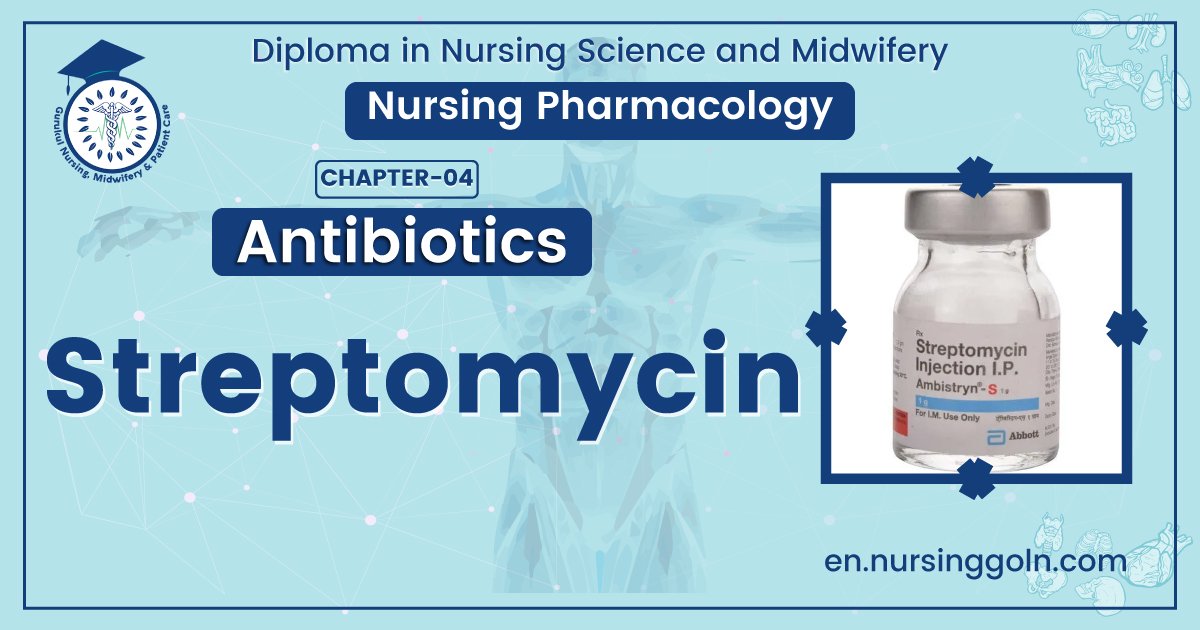Concept of Streptomycin – This book covers the entire syllabus of “Pharmacology” prescribed by BNMC- for a diploma in nursing science & midwifery students. We tried to accommodate the latest information and topics. This book is an examination set up according to the teachers’ lectures and examination questions.
At the end of the book, previous questions are given. We hope in touch with the book students’ knowledge will be upgraded and flourish. The unique way of presentation may make your reading of the book a pleasurable experience.

Concept of Streptomycin
➤ Bactericidal (high dose)
➤ Bacteriostatic (low dose)
➤ Second or third line drugs of tuberculosis
Mechanism of action of Streptomycin
The mechanism of action of streptomycin is as like that of aminoglycosides
Indication of Streptomycin
➤Pulmonary tuberculosis (advanced TB, milliary TB)
➤ Subacute bacterial endocarditis.
➤Plague and tularaemia
➤ Gut sterilisation, dysentery.
➤ Urinary tract infection (UTI)
➤ Respiratory tract infection, e.g. pharyngitis, pneumonia, tracheobronchitis.
➤ Dysentery and acute brucellosis
➤ Peritonitis and meningitis.
Contraindications of streptomycin
➤ Kidney disease
➤ Disturbance of hearing
Adverse Effect of Streptomycin: Same as aminoglycosidesindheads
Gentamycin
Gentamycin is an aminoglycoside obtained from Micromonospora purpurea. It is effective against Gm (+ve) and Gm (-ve) organisms.
Indication of Gentamicin
1. Bacteraemia and septicaemia
2. Abdominal and pelvic sepsis.
3. Bacterial endocarditis.L
4. UTI cause by E. coli, proteus.
5. Infected burn.
6. Peritonitis.
7. Osteomyelitis.
8. Pneumonia.
9. Peritonitis, Meningitis.
10. Infection of ear (otitis media), nose and throat
Routes of administration:
- Injectable: intramuscular, intravenous
- Topical (creams, ointments, intrathecal)
Adverse effects: same as aminoglycosides.
Neomycin
Neomycin is an aminoglycoside obtained from Streptomycin fradiae, which was first isolated by
Waksman in 1949.

Susceptible microorganisms:
➤E. coli.
➤Enterobacter aerogenes
➤ Klebsella pneumoniae
➤ Staph. aureus
➤ E. faecalis
➤ Mycobacterium tuberculosis
➤ Pseudo. aeruginosa
➤ Neomycin is poorly absorbed from the gastrointestinal tract and is excreted by the kidney
Indications of neomycin:
➤ Topical preparation used in:
- Infected wounds.
- Infected burns.
- Infected ulcers.
- Infected dermatosis
➤ Oral preparation used in:
- Preparation of the bowel for surgery.
- As an adjunct to the therapy of hepatic coma.

Macrolide Antibiotics
The macrolides are a group of antibiotics with a macrocyclic lactone structure to which one or more deoxy sugars are attached. Erythromycin [er-ith-roe-MYE-sin] was the first of these drugs to find clinical application, both as a drug of first choice and as an alternative to penicillin in individuals with an allergy to ẞ-lactam antibiotics.
Clarithromycin [klarith-roe-MYE-sin] (a methylated form of erythromycin) and azithromycin [a-zith-roe-MYE-sin] (having a larger lactone ring) have some features in common with, and others that improve upon, erythromycin.
Telithromycin [tel-ith-roe-MYE-sin], a semisynthetic derivative of erythromycin, is the first “ketolide” antimicrobial agent. Ketolides and macrolides have similar antimicrobial coverage. However, the ketolides are active against many macrolide-resistant gram-positive strains.
Macrolide antibiotics
- Erythromycin
- Roxithromycin
- Clarithromycin
- Azithromycin
- Spiramycin
Read more:
